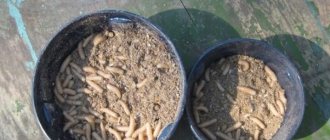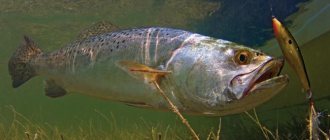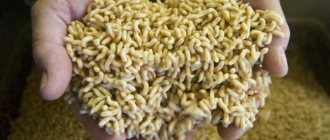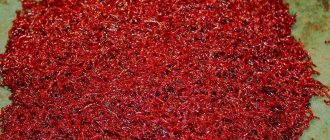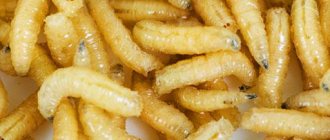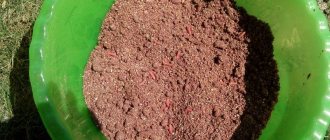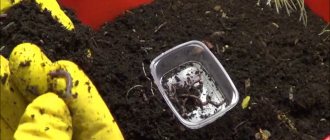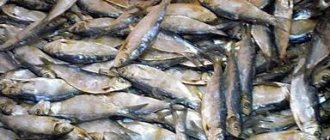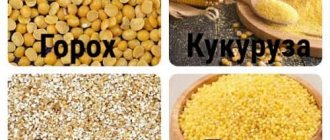Your own business growing maggots
Maggot is an indispensable fishing tackle for most who like to sit with a fishing rod... Scientifically, a maggot is called a fly larva. In fishing stores that sell baits and lures for fish, you can find three types of larvae: blue blowfly, green fly and regular housefly. The larvae of the latter turn out to be very small and very inconvenient for attachment. The method of growing all species is absolutely the same.
Growing technology
The industrial production of maggots is very specific and is not as simple as it seems at first glance.
To obtain maggots, securely closed rooms are used to prevent foreign flies and other unnecessary living creatures from entering them. The temperature in the room should be warm (+24-27 degrees) and constant. Flies are fed sugar and other sweet food. Then pieces of meat are placed in the room, in which the flies lay their eggs in heaps. Within a day, each pile yields a decent number of larvae: from 200 to 500 pieces.
The larvae are then placed in large containers up to 5 meters wide. From one such container you can get up to 50 liters of maggots. The larvae are fed animal, poultry or fish meat. In just 7 days, a marketable maggot grows from a small larva. From 100 kg of meat you can grow 50 liters of maggots. To make the maggot red (and by default, it is white), a special coloring agent is added to the meat - rhodamine B.
The final stage is collecting and sorting maggots. As soon as the larvae have gained the required weight, the pieces of meat rise above the collection containers, into which the maggots fall. The larvae are then sifted through a sieve to remove foreign impurities. The maggots, ready for sale, are placed in small boxes with sawdust and sent to the shelves of fishing stores.
How much can you earn?
If you find a wholesale buyer of maggots in large quantities, the business will bring good income. In what other agricultural business can you grow 300-500 kg of finished, and far from cheap, products out of nothing in 7 days?
The cost of one liter of maggots at the wholesale price is at least 900 rubles. In 7 days, from 1 ton of meat we can get 500 liters of maggots. In just a week, revenue will be 450 thousand rubles.
In England, some farmers produce simply unrealistic volumes - up to 20,000 liters of maggots per week. If we convert it into our rubles, we get simply cosmic profits: up to 18 million rubles. On an ordinary fly larva. And you say the most profitable business is oil and coffee...
Business pitfalls
Despite all the benefits of the business, the complexity of its organization can be the very stumbling block that stops most novice entrepreneurs.
Here are just a few reasons that make commercial cultivation of maggots difficult:
1. Strong smell. Fly larvae produce incredible amounts of sulfur dioxide and ammonia. This smell is not only very unpleasant, but also harmful to humans. It is for this reason that European countries closed most of the farms that used the simplest technologies for producing maggots.
2. Labor force. Not everyone will agree to work in such a specific production. Therefore, you will either have to pay high wages or be prepared for high staff turnover.
3. Where can I get raw materials for growing? Also a relevant question. Tons of meat will need to be supplied weekly. Buying fresh meat is expensive; you need to look for a product that is not entirely fresh. Perhaps butcher shops, livestock farms and other enterprises whose activities are related to the circulation of meat and poultry products will help in resolving this issue.
4. Search for marketing channels for maggots. It’s not at all easy to sell 1000 liters of maggots. Here you have two ways to sell maggots: sell it to wholesale resellers at discounted prices or arrange supplies to retail chains on your own. The second option is more profitable, but will require huge labor and time costs. You can't do it without good managers. You will need to visit hundreds of fishing stores, and perhaps not in one large city. And not everywhere you will be welcomed with open arms. Most stores have been working with reliable maggot suppliers for a long time, and they are satisfied with everything.
Technology for growing maggots on an industrial scale
Fifa, gozzer and others In a recent publication (No. 37 of this year) “Flies that surround us,” we mentioned the so-called carrion flies, the life cycle of which is closely related to rotting meat. In addition to the sanitary function in nature associated with the disposal of the corpses of dead animals, these types of flies have proven useful to fishermen. About the benefits Such genera of carrion flies as Lucilia, Sarcophaga and blue blowfly (Calliphora) are specially bred by humans to obtain larvae. Their larvae are called “maggots”. Inveterate fishermen claim that this is one of the best baits for spring fishing. In addition, maggots are used in feeding aquarium fish and exotic pets. In a number of medical centers in Europe and the USA, maggots are used as a cheap, effective and safe way to clean wounds from dead tissue and suppuration. For this purpose, the larva is placed on the wound. After some time, the maggot eats all the dead tissue, leaving the wound clean. Industrial production of maggots was first established in France at the end of the 19th century. Currently, it is mostly produced in Poland, and recently Russian maggot producers located in the regions of industrialized centers (Moscow, St. Petersburg, Volgograd, etc.) have become more active. During its production, strict adherence to technology is necessary to guarantee the sterility and safety of the fisherman, as well as to prevent the spread of infectious diseases. Types Depending on what flies manufacturers use, there are several types of maggots. The fifa species is the larvae of certain species of the lucilia fly. The Lucilius blowfly is a typical inhabitant of corpses. She lays up to 200 eggs at a time, hiding them deep in the corpse in a shaded place. A day later, larvae hatch from the eggs, which continue their development in the dead body. Depending on the air temperature, fly larvae can develop within 10–150 days. Lucilia maggot is produced in red, yellow and white colors. The larvae of this fly are thin, resistant to cold, so they can be stored for a long time (for several months) in the refrigerator at a temperature of 2 to 4 degrees Celsius. Fifa maggots are easy to put on a hook, and due to the short length of the larva, you can catch a lot of fish with the same maggot. Fifa is suitable for fishing any fish. “Pink” maggot is also obtained from Lucilia eggs. This is a small but very mobile species of maggot. Its length rarely exceeds 1 cm. When fishing, it holds well on the hook. Experts advise placing several specimens of the hook on the hook at the same time, so that such bait is easily visible to the fish. Bream and roach, as well as species of white fish, are good for catching with pink. It is also suitable for winter perch fishing. Moreover, red larvae are more effective than white or yellow ones when catching predatory fish. Heavy, easily sinking maggots are called “maggot”. It is ideal for complementary feeding. This is a delicate, bright white larva of one of the calliphora species - the blue blowfly. Blue carrion flies are quite large in size and reach a length of 8-13 mm. This dark blue insect with a metallic tint is very prolific. Within 15 minutes it can lay 60-100 eggs. In total, the fly lays up to 600 eggs, from which larvae hatch in less than a day. The fly lays its eggs both in carrion and in the excrement of animals and people. She often flies into our houses and tries to lay her eggs on fresh meat. The development of larvae lasts 10-12 days. Gozzer maggots are obtained using another type of calliphora. These are quite large (up to 2 cm) larvae with a rigid body. Gozzer is considered a delicacy for fish and is highly prized by fishermen. Its disadvantages include rapid pupation. Therefore, it is problematic to store it for a long time, and gozzer is stored at a temperature of 0 to 3 degrees Celsius. To grow maggots of the "gordini" species, the gray blowfly - sarcophagus - is used. Translated from Greek, “sarcophagus” means “meat eater.” On the back of the ash-gray fly there are brown stripes with a silvery tint, decorated with a checkerboard pattern. The body length of the fly reaches 10-14 mm. About 2.6 thousand species of this fly are known in the world, and about 300 species live in Russia. This is a viviparous insect, i.e. it does not lay eggs, but produces live larvae. It stands out for its record fecundity among carrion flies. There is evidence that a sarcophagus can give birth to up to 20 thousand larvae during its life. At one time, the fly produces 30 larvae. Having reached the age limit, the fly larva leaves the rotting flesh of the corpse and buries itself in the soil, where it pupates. Adult flies hatch from the cocoon and climb to the soil surface using an original method. They do not have legs capable of raking the earth, and the mouthparts of the fly are not adapted for such work. But on her head there is a huge elastic forehead bubble, almost three times the size of the head itself. The fly inflates a bubble and it pushes away the soil particles. Then, when the bubble collapses, the fly takes up the free space where the bubble was. Sarcophaga larvae (“gordini”) are quite long (20–25 mm) and tender. They are used to catch large fish. True, such bait has to be changed often, since it is easily sucked out by fish. Breeding at home Until recently, a large army of amateur fishermen bred maggots at home or purchased them from enterprising citizens who had established their own artisanal production of this product. In principle, growing maggots yourself is not difficult. It is enough to place a piece of rotting meat (lung, liver) or fish on the balcony or garden plot. The smell of spoiled meat attracts carrion flies throughout the area. To obtain slightly rancid meat, wrap it tightly in a plastic bag and leave it for a day at room temperature. The use of rotten meat is especially important in the spring, when the flies are still weak and fishing is not waiting. It should be noted that in the spring, flies often do not immediately lay their eggs in the bait, but do so several days later. But in the summer, the bait set out in the morning can be thickly stuffed with fly eggs by the evening. A day after oviposition, the bait is moved into a small plastic container, the bottom of which is lined with dry rotted sawdust and covered with burlap, in which holes are made for free access for flies. The basin is left in the shade, in places inaccessible to pets. The larvae, having eaten the remains of the bait, need food. The best quality maggots (large, fleshy) are obtained by feeding them with products of animal origin (meat, fish, fish meal, cottage cheese, bird eggs). Offal is ideal for feeding larvae. The temperature at this time should not exceed 35 degrees Celsius. The duration of development of the larvae of most carrion flies is 10-15 days, after which it turns into a fly. If there are a lot of larvae, then more mature individuals are selected for fishing. Young larvae are kept in the refrigerator at a temperature of about 0 degrees and are used for further feeding and rearing. The maggots are selected from the spent substrate using a sieve with a cell diameter of 6-8 mm. The spent substrate along with maggots is poured in small portions into a sieve, evenly distributing it over the surface. The sieve is placed over a basin or box, where the larvae escape through the holes of the sieve to escape sunlight. They are collected, winnowed and placed in jars, sprinkled with moistened sawdust. An important characteristic of the quality of maggots is its ability to survive for a long time in the form of a larva without turning into a fly. It is known that under unfavorable conditions the larvae plunge into a state of suspended animation. This is the name given to the state of an organism in which life processes slow down sharply, which contributes to its survival in unfavorable conditions of temperature, humidity and other conditions. In a state of suspended animation, the larvae can withstand frosts of up to 30 degrees. Fly larvae remain viable for up to 2 years at subzero temperatures. Maggots prepared at home are stored for almost two months in glass jars in the refrigerator at a temperature of 0 to 4 degrees Celsius. You can also freeze maggots for long-term storage in the refrigerator. You just need to thaw them at room temperature, and not on the battery. After thawing at room temperature, maggots come to life. When breeding maggots at home, the bait is simultaneously colonized by several types of carrion flies, so in this case it will be impossible to talk about obtaining fifa, gozzer, magot, pink or gordini maggots in their pure form. Here everything will depend on what kind of flies flock to the smell of rotting meat. Coloring As for coloring maggots, it can be easily done in an industrial environment. For this purpose, special food dyes are used, which are added to the substrate for feeding the larvae. You can tint maggots before fishing at home using food coloring for Easter eggs. The coloring solution is prepared as follows. Pour a bag of Easter paint into a plastic bowl filled with bran and add water to make a semi-liquid paste. Then maggot is added here in a 1:1 ratio. The resulting mixture is kept warm and in the light. To prevent the larvae from scattering, the walls of the pelvis are sprinkled with bran or sawdust. Adding flavoring to the pulp gives the maggot a certain aroma, but only for a short time. The coloring procedure lasts 4–6 hours. After coloring is completed, dry bran is added to the slurry to reduce moisture, and then the substrate is sifted so that the maggot remains on the sieve. The diameter of the sieve cell is 1–2 mm. There are other ways to color maggots. So, for example, if you feed chicken yolk to the larvae, they will acquire a pronounced yellow tint. And in order for the larvae to turn red, you need to briefly hold them in milk with the addition of beet juice or red food coloring. The attractiveness of the bait can be enhanced if, before fishing, you marinate the maggots in vinegar and then fry them in the oven. Industrial production Currently, in our country and in the world, there is an industry for breeding carrion flies to produce maggots using the latest achievements of biotechnology. Carrion fly larvae are produced in special workshops equipped with bioreactors, where at each stage of the technological process the temperature, humidity and light parameters necessary for certain phases of insect development are strictly maintained, and the quality of the nutrient substrate is strictly controlled. Even breeding work is being carried out to obtain breeding lines of flies, the maggots of which are stored for a long time and are of higher quality. Russian maggot producers, as a result of breeding work with the Kenyan (African) fly population, have obtained a selection line of maggot GV No. 2-S, which belongs to the pink type. It was created specifically for fishing and can be preserved alive for years in the refrigerator at a temperature of 3-5 degrees Celsius. Outside the refrigerator, at a temperature of 25-30 degrees, such maggots can be stored without loss of quality for a month. An important property of this breeding line of maggot is that it is grown using fresh raw materials, without the use of any waste. This is achieved through special fermentation of the medium, which completely eliminates putrefactive processes.
By admin
Add a comment Cancel reply
You must be logged in to post a comment.
© 2021 About construction and more | Theme by Themeansar
Maggot breeding business - production technology, secrets of making huge profits
Growing maggots at home can be simplified even more, and there are also original ways to breed them.
This type of maggot can be easily made at home or right on the shore of a pond after fishing. Take a plastic bottle and cut it in half into two parts. Pour a layer of sawdust 5-7 centimeters thick into the lower part. Unscrew the cap and insert the top of the bottle into the bottom, neck down.
In this case, the neck should not reach the sawdust by a couple of centimeters. Next, we put a dead fish, a half-eaten egg, sausage or meat at the top and place the “device for producing larvae” in the shade in a secluded place. When we arrive fishing a week later, we take out the structure and select ready-made larvae.
Above the water
This method of growing is also interesting. On a pond you frequent, choose a tree with a branch overhanging the water. Attach a jar with a holey bottom to this branch. Place a fish or piece of meat in the jar.
Hatching maggots will fall into the water and attract fish to this place. While fishing, all you have to do is throw your tackle with maggots on a hook under a branch and catch fish that are accustomed to feeding on larvae.
From eggs
The largest larvae for fishing are obtained from raw or rotten eggs. One fisherman aptly described them as “Michurinsky”. The technology for producing giant maggots is very simple, but it is better not to use it at home because of the very specific “fragrant” smell.
- We take a container and pour a layer of sawdust five to ten centimeters into it, for example, a low old saucepan.
- We place the eggs vertically in the sawdust, strengthen them with sawdust so that they do not fall.
- We break the top of the shell and wait for the flies to arrive.
- Each egg hatches 20-30 larvae, but all of them are “Michurinsky”, some of them can get out of the shell into the sawdust.
To begin with, I thought about a room for growing maggots and keeping the flies themselves. The main reason for most failures in home breeding of maggots for sale is precisely incorrect maintenance.
The thing is that despite the unpretentiousness of the fly, changes in temperature greatly affect both the number of clutches and their size, the same thing happens to the larva itself. And to be honest, the smaller and slower they grow, the less money you earn.
Of course, I didn’t spend money on full-fledged ventilation equipment; I made do with a number of household appliances and a temperature sensor with the function of automatically turning on and off the “constructed” system. By the way, ventilation is one of the most expensive expense items; as it turns out, the release of ammonia during the growth and development of fly larvae (maggots) is very impressive.
For the flies, we built two small boxes covered with fine mesh, meter by meter in size, with a hard bottom; for the larvae, we stocked up on several bags of sawdust and bought five plastic containers (I still don’t know why there are five).
To be honest, after a long study of the “predilections” of flies, we took the simplest route, went to the nearest poultry farm and bought a dozen “crushed” chickens for a nominal fee. I immediately agreed with the foreman about “systematic” feed supplies.
We suggest you read: Is it possible to freeze sea buckthorn for the winter?
We approached this issue from a purely scientific point of view and formed two herds at once:
- First, with the help of simple flytraps, they caught meat flies in the area of the same poultry farm, and from the total number they tried to select only flies of a certain species. Of course, I’m not an expert, but large green flies were selected based on their appearance.
- The second was bred from purchased maggots.
Without lying for long, a chicken cut into several parts was placed in cages with flies, on which the flies quickly laid eggs.
Then they transferred the fly eggs, along with pieces of meat, into separate containers with sawdust. In which, in fact, the further development of maggots takes place at home, from the moment of hatching to the acquisition of a marketable form.
At this stage, we encountered a number of difficulties, ranging from the fact that the larvae stopped growing to the fact that they simply died, of course not all, but most of them. The fact is that in order to obtain the maximum result, it is necessary to provide the most comfortable conditions, and here you also need a certain humidity and prevent active rotting of the feed.
Ultimately, after two months of active work on “selection” and development of the correct methodology, we received the first “harvest” in the amount of one hundred grams of maggots grown at home.
Stage five of business ideas for breeding maggots at home.
Organization of product sales. With the sale, everything turned out quite simply; in the nearest store, the grown maggots were given away for sale. They buy Polish products for real money, but here it’s like on credit.
By the way, the maggots from the “green” flies were not very large, but they were not very different from their Polish counterparts.
In addition, I can say that when the maggot was brought to marketable condition, it was placed in the refrigerator, where it was stored for a fairly long period of time.
Advantages of a home-based business based on maggots.
— To create a business for growing maggots, you need a minimum start-up capital.
— High turnover and profitability of the process of breeding maggots at home. De facto, from the moment of start (egg laying) to the receipt of marketable maggots, it takes 7-8 days.
— Possibility of creating such a business at home.
Disadvantages of a business idea for growing maggots.
— The need to create your own technology; in fact, you won’t find a ready-made “recipe” for breeding on the Internet; you need to try most of the processes yourself.
— Certain aesthetic issues, not everyone will be able or want to breed maggots in large quantities. Plus the smell itself from the “feeding” and vital processes of flies and maggots (at least the smell of ammonia).
As an epilogue
After assessing all the pros and cons, we clearly identified the enormous prospects of this market and the business idea of breeding maggots. We have now begun to conduct experiments with other types of flies to ensure year-round cultivation (we grow the so-called housefly).
Of course, it is very far from industrial scale, but I am quite seriously considering the possibility of creating a small farm. If you have experience in breeding, I will be glad to hear your advice or share your experience. I will be very grateful.
Business idea - breeding maggots at home
Every person at least once in his life has set himself the goal of starting an entrepreneurial activity and creating his own thriving business.
The most important thing at the initial stage is to competently and correctly choose the niche of your future business. Next, the only thing left to do is to write a business plan that will take into account all the costs, risks and nuances of the planned enterprise for the near foreseeable future.
Sometimes the idea and essence of the future business is on the very surface, and we cannot always pay attention to it. Such ideas can easily include a business for breeding maggots at home.
Not every owner of a house in a semi-abandoned village thinks about this way of additional income.
Business under your feet or how to make money on other people's hobbies
Often, in search of business ideas, we go through many options, looking for “ours” among the mass of useful and not very useful information, but we very rarely look around, often finding ourselves in a situation that can be characterized by the proverb “You can see a speck in someone else’s eye, but you cannot see a log in your own.” " I’ll start from a little distance, to get a complete picture both from the consumer (read potential buyer) side and from the business itself.
This summer has turned out to be quite difficult on a personal level, on the one hand, roughness at work associated with factors that I personally cannot influence, on the other hand, the same friction in other aspects of life, all this cannot affect the general condition. As a result, to put it mildly, I began to “give up” and urgently needed psychological relief. After going through a lot of options, I came to the conclusion that fishing could be such an outlet. It sounds banal, of course, but the option turned out to be not bad, although I myself am not an experienced fisherman, it’s very suitable for unloading. The result was, if not regular, then quite frequent trips to both paid rates and “public” reservoirs. As the fisherman said, I don’t have much experience and “inclinations,” so fishing is quite primitive using the simplest fishing rods and bait. Anyone who has experienced fishing will not let you lie that the huge variety of baits and groundbaits in fishing stores is very good, but for most types of fish (the exception is the so-called “carp fish”) the best option is a banal worm and maggot. That is, we use bait to “lure” the fish, but the bait is still the same traditional worm and maggot. Of course, professional fishermen can smile and start a heated debate, but I repeat, from the point of view of the vast majority of the same amateurs, there is no better option.
Getting ready to go fishing every weekend, I, like a huge number of the same “lovers”, began my trip with a trip to the store for pollocks and an outing to “digging” worms. Everything seemed clear and quite banal, until a real emergency happened (I’m joking, of course), when I went into the store again, I heard the news: “There are no maggots and there won’t be for 10 days.” The news is certainly not comforting, but it interested me personally; in the end, the following turned out to be true:
- – maggots for stores are imported from Poland (personally, I could never even think of such a thing);
- – due to difficulties at the border, the next shipment was simply stopped and a vacuum was created;
- – in our region no one is engaged in independent breeding of maggots.
Read also: How to grow onions at home in winter in water
Of course, the situation would be funny if it weren’t so sad; by the next weekend, even artificial maggots, which were positioned as a replacement, disappeared from store shelves. In addition, it was also not possible to “dig” worms on your own; the heat took its toll and the worms disappeared quite abruptly (in any case, in order to collect the required number, it took half a day to search). We quickly sorted out the worms and started purchasing them from a friend who was breeding them, but this didn’t work out with the maggots.
Actually, at this stage, I asked myself one simple and banal question: why is it profitable to breed maggots in Poland, taking into account transportation and “mandatory” payments at the border, but not here?
After studying the situation and reading a little specialized literature describing the life cycle of flies, maggots are actually fly larvae, I decided to check how it works. The goal can be characterized by whether it is possible to create a business for breeding maggots at home. Let me make a reservation right away: I did not conduct the experiment at home (I live in an apartment), but in the private sector using a closed room. Roughly speaking, a barn or other unused room with temperature control is suitable for such purposes.
What should the room be like?
As in any other business, growing maggots has its own nuances. In this case it is the smell. During their maturation, the larvae emit an extremely unpleasant and toxic odor of ammonia to humans, which spreads to nearby areas.
The room must be systematically ventilated from toxic substances, but not too diligently - the larvae do not like this. The neighbors won’t appreciate such an impulse either. Do not forget to ensure that other insects do not enter the farm during ventilation!
As for the moment of registration, it will not be superfluous to register as an individual entrepreneur. No documents will be required to start a business, nor will it be necessary to obtain special licenses.
When choosing a room, we strongly recommend that you pay attention only to those places that are remote from residential buildings! This will protect you from endless complaints and subsequent problems with neighbors. The most optimal area for a future base is a place near a sparsely populated village.
In addition to the location of the planned farm, the correct climate and temperature conditions are important. The most optimal air temperature for breeding insects ranges from 23 to 24 degrees Celsius.
It is worth considering that unscheduled temperature changes will not kill insects, but can negatively affect the size of the larvae. Breeding maggots as a business is impossible if you do not maintain a high level of air humidity (50-70%), because it has a beneficial effect on reproduction.
How to equip a room for breeding maggots
First of all, it must be said that the further the maggot breeding room is from living rooms and houses, the fewer problems you will have with your neighbors. The fact is that during its growth, maggots emit a very pungent odor of ammonia. Imagine how 50 kilograms of such fishing bait can smell! What about 100 kilos? How about 200? The smell will spread not only throughout the house, but throughout the entire area. Therefore, the ideal option for growing maggots at home is a separate building in the country or in the village. Here, by the way, you can organize the breeding of worms - another excellent bait for fishing, which is in great demand.
It is the room and the suitable conditions created in it for the appearance and growth of maggots that affect their quality, growth rate, and, accordingly, your profit. All this can be achieved and increased in three ways:
- Maintaining optimal temperature. Maggots need a constantly maintained temperature of 23-250C. Temperature “jumps,” of course, will not destroy the larvae, but will significantly affect their growth.
- Air humidity is from 50 to 70%. This is an ideal environment for rapid reproduction of maggots.
- Ventilation. This condition is mandatory precisely because of the ammonia released by maggots, which, as is known, is not only harmful, but also toxic.
The room must be tightly closed to prevent the entry of foreign flies or any other insects eager to feast on the “rotten meat”. In addition, maggots do not like too bright light, so care should be taken to provide adequate lighting.
How are larvae reproduced?
Due to the risk of deposition of larvae in an environment favorable for this by other insects, it is recommended to breed maggots in plastic containers. The technology of maggot breeding as a business involves maintaining optimal temperature and humidity in the room.
These insects love moisture, so stock up on sawdust in advance, which will absorb a large amount of moisture. In large industries, as a rule, containers with a width of up to 5 meters are used, but in home production they can be smaller.
From one container in just a week, a good breeder can grow up to 60 liters of maggots!
The finished product is collected exclusively over prepared containers from bottles. The pieces in which the worms live need to be shaken thoroughly and then further sifted for cleaning. It is better to store the collected “wealth” until sale in plastic containers covered with sawdust.
The necessary personnel for such a business is the owner himself, who will be able to service the farm on his own. The main thing is to monitor the temperature and humidity.
There is another - “summer” and more economical way of breeding bait, but it negatively affects the quality of adult fish. The method involves breeding larvae in plastic bottles.
To do this, they need to be cut so that the upper part is approximately twice as large as the lower part. We twist the cork and insert the cut top of the bottle down. In this case, food that will attract flies and in which insects will breed is placed on top, and wet sawdust on the bottom.
As they mature, the larvae will gradually find their way into the lower part with sawdust. Getting started is as easy as shelling pears; you don’t need to buy specialized equipment.
Other production methods
Growing maggots at home can be simplified even more, and there are also original ways to breed them.
In a plastic bottle
This type of maggot can be easily made at home or right on the shore of a pond after fishing. Take a plastic bottle and cut it in half into two parts. Pour a layer of sawdust 5-7 centimeters thick into the lower part. Unscrew the cap and insert the top of the bottle into the bottom, neck down.
In this case, the neck should not reach the sawdust by a couple of centimeters. Next, we put a dead fish, a half-eaten egg, sausage or meat at the top and place the “device for producing larvae” in the shade in a secluded place. When we arrive fishing a week later, we take out the structure and select ready-made larvae.
Above the water
This method of growing is also interesting. On a pond you frequent, choose a tree with a branch overhanging the water. Attach a jar with a holey bottom to this branch. Place a fish or piece of meat in the jar.
Hatching maggots will fall into the water and attract fish to this place. While fishing, all you have to do is throw your tackle with maggots on a hook under a branch and catch fish that are accustomed to feeding on larvae. Make new stockings from time to time, then you will not need to take care of the bait all season.
From eggs
The largest larvae for fishing are obtained from raw or rotten eggs. One fisherman aptly described them as “Michurinsky”. The technology for producing giant maggots is very simple, but it is better not to use it at home because of the very specific “fragrant” smell.
- We take a container and pour a layer of sawdust five to ten centimeters into it, for example, a low old saucepan.
- We place the eggs vertically in the sawdust, strengthen them with sawdust so that they do not fall.
- We break the top of the shell and wait for the flies to arrive.
- Each egg hatches 20-30 larvae, but all of them are “Michurinsky”, some of them can get out of the shell into the sawdust.
Why do you need food for flies and how to feed them correctly?
Quality fly food is vital to growing high quality fishing bait. Therefore, every breeder who is interested in selling his product should closely monitor this issue.
The best bait for flies: boiled eggs, leftovers, rotten vegetables, dairy products, flour products and, of course, spoiled meat. They happily eat flies and offal and meat waste that remains after cutting animals. The same products, but in crushed form, can be given to the larvae.
To breed maggots at home at minimal cost, you can negotiate with a nearby poultry farm to purchase illiquid goods and waste.
By law, meat production must dispose of such waste, however, no one wants to incur additional losses. In most cases, such an offer will be accepted with great interest.
How to feed flies that will lay larvae?
There are several subtleties here. First you need to decide what kind of maggots you would like to get as a result. Every knowledgeable person will say that there are simple, small maggots, and there are thick ones, also called “meat maggots.” You can feed flies with anything: flour, spoiled vegetables, boiled chicken eggs, fish, cottage cheese. However, the meatiest and largest maggots will be obtained if you feed the flies meat. To do this, there is no need to use fresh meat that is edible. This may be a spoiled product. But by-products are best suited: liver, heart, stomach and other things that remain when cutting any animal. The same, but only in crushed form, must be fed to the maggots themselves.
Read also: What crops are grown in the USA
“Getting” such leftovers is not that difficult. You can negotiate with local farmers who will gladly give away a substandard product or a second-class product for a symbolic price. It is especially good if you have an individual farm with animals. You can make waste-free and environmentally friendly production.
As for the type of flies that will lay larvae, from a logical point of view it makes no difference what they will be. If we are talking about rationality and productivity, then, without a doubt, you need to choose a special type of fly. Among them are Calliphora vormitoria (gray blow fly), Calliphora vicina (blue blow fly). These are the largest flies.
A distinctive feature of this business is that you can produce products in unlimited quantities, while receiving a new batch every 6-7 days. Already on the 3-4th day, you can remove the larvae from the sawdust to prevent them from turning into “pupae” and going deeper into the container. It is important not to miss this moment, since no one needs an overripe product.
What is the cost of the product and possible profit?
Growing flower seedlings in a greenhouse for sale.
The most important expense items include:
- Utility costs: electricity and water will cost approximately 20,500 rubles. per month.
- 15 tons of raw materials (chicken mortality): it is extremely unlikely that anyone will sell it. For order, you can estimate 1 kg of waste at 1 ruble, a total of 15,000 rubles.
- The cost of renting land and premises - let’s assume that you are the owner of this enterprise and pay exclusively utility bills.
- Consumables – 15,000 rub. per month.
Total expenses per month: 150 thousand rubles. In this case, the cost of one liter of live maggots will be approximately 30-35 rubles. As for the cost of dried maggots and zoohumus, the cost will remain equal to zero.
The average market value of maggots at wholesale prices remains high - approximately 900 rubles per 1 kg of product! If you find at least one wholesale buyer of fishing bait, then the business will prosper. How much you can earn depends only on sales volumes and whether you can establish distribution channels.
Maggot breeding as a business in Russia
Many people, thinking about which area of the national economy to start their own business, consider raising ostriches, pigs and other animals as an idea. Owners of country houses located near natural or artificial reservoirs are trying to develop fish farming as a business. To implement such a project, they do not need to have too much start-up capital; the main thing is to find a place, purchase fry and always keep food, for example, worms or maggots, in stock.
What types of maggots can be bred at home?
If an entrepreneur plans to breed maggots on an industrial scale, then he must first decide on the type of fish bait. To begin work, he needs to find an area where containers with larvae can be placed. If breeding worms at home for fishing does not require the construction of any premises, then with maggots the situation is a little more complicated.
The following types of maggots are commonly used in fishing:
- ordinary (room);
- green;
- meat (blue).
When starting to breed maggots on an industrial scale, you should choose the species that is more in demand among fishermen. For example, ordinary larvae are not in great demand because they are too small in size, which causes problems when baiting them on a hook.
How maggots are bred
Flies are attracted to rotten meat (fish or poultry) not only by its pleasant taste, but also by the opportunity to lay their larvae in an ideal environment. Few people know that one fly can lay up to 300 larvae per day. Storing and breeding maggots as a business (you can see the video below) is in practice carried out in large containers that can be easily made from plastic bottles.
Before you start growing maggots, you should stock up on a significant amount of sawdust, since the larvae require the absorption of excess moisture.
On an industrial scale, containers up to 5 m wide are used; for home use, they may be slightly smaller. From the container you can get up to 60 liters of maggots, which grow to adulthood within a week and can be sold for bait.
To collect the “harvest,” the pieces where maggots live are lifted above prepared plastic containers and shaken a little. This causes the larvae to fall off, and after this they should be further sifted to clean them. After this, the maggots wait in the wings in sawdust, which is poured into bottles so that they remove excess moisture.
There is also a summer, economical way to breed maggots . For this, regular-sized bottles are used, which must be cut so that the lower part is almost twice as large as the upper. The cork is twisted and the cut off top is inserted into the bottom. Food is placed at the top, which will attract flies, and sawdust is poured into the bottom. Adult larvae will end up there, but it should be borne in mind that this method significantly degrades the quality of adult maggots .
The seasonal nature of the business is due to the increased demand for maggots during summer holidays and fishing trips.
Why do you need food for flies and how to feed them
For those who are interested in how to grow and store maggots at home, it is important to clearly understand that in order for the adult larvae to be healthy and have a “marketable” appearance, the flies need to eat well enough.
Often scraps, boiled eggs, flour and dairy products and rotten vegetables are used for feeding, but meat undoubtedly gives the best effect.
Flies also eat offal and other parts that remain after cutting any animals with pleasure and for the benefit of their health. The same food, but in crushed form, can be fed to the larvae themselves.
This is interesting: What is a swap in finance
However, you should not think that you will have to buy kilos of meat and wait for it to spoil: in this way, instead of the expected profit, you will only experience losses.
To breed fly larvae, you will only need the residue left over from cutting up animal carcasses, dead chickens and chickens from poultry farms or fish. Finding the source of this “good” will not be a problem.
You can arrange for some of the waste to be left for you at nearby farms, poultry farms, or simply enterprises where meat is processed. By law, such remains must be buried, but in practice, businesses are usually happy to get rid of this hassle and will give you second-class or substandard goods.
You can sell maggots yourself by opening them in a fishing store, on the Internet, or sell the goods to large chains.
How to save maggots
As mentioned above, maggots can be sold within a week. When this period has passed, they should be collected and stored, otherwise they will bury themselves in sawdust and pupate, and then flies will hatch from them. You can collect the larvae with gloved hands, or you can sift the sawdust through a sieve.
The larvae should be placed in jars with fresh (necessarily wet) sawdust and placed in the refrigerator. At temperatures from -4 to -2 degrees, maggots will last for about a month .
The sale of maggots for fishing should be carried out precisely at this time, since after this time the larvae will not be of interest to fish, which means they will also lose their attractiveness to fishermen.
You should know that maggots can change color depending on their diet . From the white they turn white (although this is their main color), from the yolk they become yellow, and from the special food coloring Rhodamine B they turn red. This property can be successfully used, knowing well the demand of your consumers. You can change not only the color of the larvae, but also their smell . For example, if anise oil is added to sawdust, maggots acquire a noble smell, which not only appeals to fishermen, but also attracts the attention of fish.
Features of breeding meat maggots
If a novice entrepreneur decides to breed meat maggots on an industrial scale, then he needs to create special conditions for it. On a personal plot, a ready-made outbuilding should be erected or allocated. Inside you need to create conditions that are as close to home as possible. It is imperative to resolve the issue of heating the room, especially in the cold season. This is necessary so that the processes of rotting in leftover food are not inhibited due to temperature changes. It is necessary to place meat and other food scraps in the equipped room and make sure that flies do not get into it. After this, you need to close the doors tightly and let nature do its thing. In just a week, the entrepreneur will be able to collect his first “harvest” and transfer it for sale.
What are maggots?
For experienced fishermen, this is not a mystery: they know well why maggots are needed for fishing. Breeding them as a business is of more interest to those who want to start their own business with a minimal investment of start-up capital.
If you have a rich imagination and a heightened sense of disgust, you are better off starting your own business in a different direction. However, in reality, maggots are just fly larvae.
For the most part, the larvae of only a few species of these insects are used for fishing:
- meat (blue);
- green;
- indoor (ordinary).
The larvae of regular flies for fishing are used less frequently than others because they are smaller in size and can be quite difficult to attach to a hook.
At the same time, breeding maggots on an industrial scale and in conditions close to home ones are almost the same: for this, the process of rotting food remains is used.
Despite the fact that every year they come up with new bait for fish, none of them have yet managed to surpass maggots, which are something of a delicacy for fish.
It is enough to place several pieces of meat or other leftover food in a warm room where there are flies inside, so that within a week you can collect maggots ready for sale.
How to properly arrange a room?
Most country residents who breed crayfish are planning to expand their business. After studying various projects, they decide on worms and maggots. The process of breeding maggots on an industrial scale requires compliance with certain technologies.
Advice : the room in which maggots will originate and develop should be located as far as possible from residential buildings. This is due to the fact that during the processes of rotting meat and other food debris, a strong stench (the pungent smell of ammonia) arises.
In the room that will be allocated for breeding maggots on an industrial scale, the following conditions must be created:
- It is important to maintain humidity in the range of 50-70%.
- The room must be hermetically sealed to prevent the entry of foreign insects.
- The temperature should fluctuate in the range of 23-25 degrees.
- The room should have windows through which it can be ventilated (this should not be done too often).
Breeding maggots on an industrial scale in the summer can be done outdoors. To do this, in the far corner of the garden plot you need to install several containers in which biological waste must be placed. After throwing flies into them, you should close the lids and wait a few days before collecting the first batch of maggots.
Tip : one fly can lay about 300 larvae. An entrepreneur who plans to start a maggot business should take this nuance into account.
Justification of a commercial idea
The agricultural sector is one of the main polluters of the environment. Organic waste from livestock farms causes enormous damage to soil and water. Artificial breeding of maggots not only solves the problem of waste disposal, but also allows you to obtain a lot of useful products:
- Live biomass of larvae, which can serve as food for farm animals
- An indispensable fishing bait of animal origin
- Zoogumus is a very valuable fertilizer that stimulates the growth and development of plants, increases productivity, promotes soil reclamation and frees it from heavy metals.
- Flour (a product of processing dried maggots), which in its properties is several times superior to meat and bone meal, is used as an additive for combined feeds
Note: larval biomass is especially effective when breeding fish species such as carp and trout.
As practice shows, if maggots are introduced into the diet of fish, the survival rate of fry increases, the risk of disease decreases, and individuals gain weight twice as fast as usual. In addition, flour obtained from dried fly larvae is a raw material for the production of oncology drugs and is widely used in cosmetology. There are only a few enterprises in Russia engaged in breeding maggots on an industrial scale. That is, this niche is practically unoccupied. The low level of competition, the absence of the need for large start-up and ongoing investments, as well as ample opportunities for selling finished products make this business idea relevant and promising.
